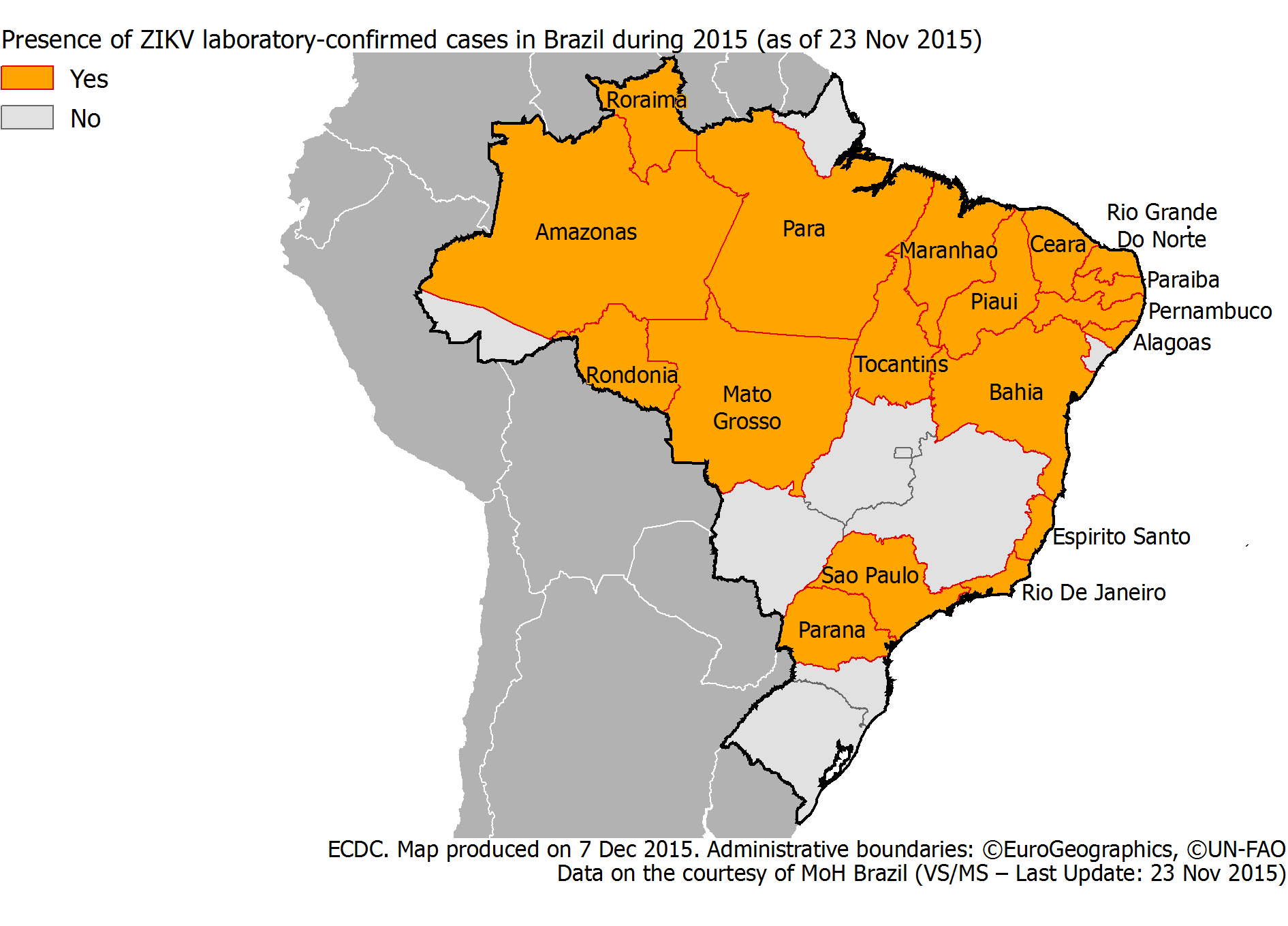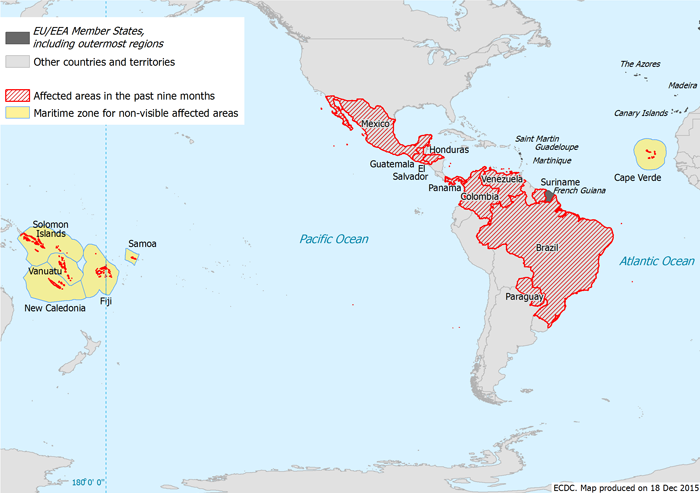Zika Virus Outbreaks: Here and There
December 22nd, 2015
Epidemiological update: Outbreaks of Zika virus and complications potentially linked to the Zika virus infection
18 Dec 2015
Europe
No autochthonous cases of Zika virus infection have been reported in EU Member States so far in 2015. In the past month, one imported case was reported in the Netherlands in a traveller who returned from Suriname on 29 November 2015 after a 3-week holiday in that country.
No autochthonous cases of Zika virus infection have been reported in EU Member States so far in 2015. In the past month, one imported case was reported in the Netherlands in a traveller who returned from Suriname on 29 November 2015 after a 3-week holiday in that country.
Americas
Brazil
Autochthonous transmission of Zika virus infection has been reported in Brazil since April 2015. As of week 47/2015, 18 states in Brazil have reported locally-acquired cases [1].
Autochthonous transmission of Zika virus infection has been reported in Brazil since April 2015. As of week 47/2015, 18 states in Brazil have reported locally-acquired cases [1].
Other countries in the region
As of 17 December 2015, nine countries in the Americas, in addition to Brazil, report confirmed locally-acquired cases in 2015: Colombia, El Salvador, Guatemala, Mexico, Panama, Paraguay, Suriname, Honduras and Venezuela [2,3].
Pacific region
Since the beginning of 2015, sporadic autochthonous cases have been reported in Samoa, Fiji, New Caledonia, the Solomon Islands, and Vanuatu [4]. New Zealand reported two imported cases from Samoa.
Since the beginning of 2015, sporadic autochthonous cases have been reported in Samoa, Fiji, New Caledonia, the Solomon Islands, and Vanuatu [4]. New Zealand reported two imported cases from Samoa.
Africa
On 3 November 2015, the Cape Verdean Ministry of Health reported an outbreak with around 1 000 suspected cases [5]. Seventeen out of 64 blood samples that were sent for confirmation to the Pasteur Institute in Dakar were positive for Zika virus [6].
On 3 November 2015, the Cape Verdean Ministry of Health reported an outbreak with around 1 000 suspected cases [5]. Seventeen out of 64 blood samples that were sent for confirmation to the Pasteur Institute in Dakar were positive for Zika virus [6].
Complications potentially linked to Zika virus infection
Microcephaly and central nervous system malformations Brazil
Possible links between Zika virus infection in pregnancy and microcephaly of the foetus have been under investigation in Brazil since October 2015 when the Brazilian Ministry of Health reported an unusual increase in cases of microcephaly following the Zika outbreak in the north-eastern states.
As of 12 December 2015, 2 401 suspected cases of microcephaly, including 29 deaths, have been notified in Brazil in 549 municipalities in 20 states. Of these 2 401 cases, 134 were confirmed as being related to Zika virus infection according to the applied case definition, 102 were discarded and 2 165 are still under investigation [7,8]. In week 49/2015, six new states reported suspected cases: Espírito Santo, Mato Grosso, Minas Gerais, Pará, São Paulo and Rio Grande do Sul [8].

Table 1. Distribution of the number of suspected cases of microcephaly notified in Brazil in 2015, as of 17 December 2015 (n = 2 401)
| Brazilian states | Cases of microcephaly under investigation | Confirmed cases* | Discarded cases* |
|---|---|---|---|
| Pernambuco | 874 | 29 | 17 |
| Paraíba | 322 | 19 | 30 |
| Bahia | 316 | 0 | 0 |
| Alagoas | 107 | 0 | 0 |
| Rio Grande do Norte | 101 | 35 | 4 |
| Ceará | 79 | 0 | 0 |
| Mato Grosso | 72 | 0 | 0 |
| Rio de Janeiro | 57 | 0 | 0 |
| Maranhão | 56 | 0 | 7 |
| Tocantins | 43 | 0 | 7 |
| Piauí | 39 | 0 | 0 |
| Minas Gerais | 33 | 0 | 2 |
| Sergipe | 33 | 51 | 34 |
| Espírito Santo | 14 | 0 | 0 |
| São Paulo | 6 | 0 | 0 |
| Goiás | 4 | 0 | 1 |
| Mato Grosso do Sul | 3 | 0 | 0 |
| Pará | 3 | 0 | 0 |
| Distrito Federal | 2 | 0 | 0 |
| Rio Grande do Sul | 1 | 0 | 0 |
| Total | 2 165 | 134 | 102 |
*According to case definition reported in [7].
Guillain–Barré syndrome
Investigations of an association with Zika virus infection and Guillain–Barré syndrome (GBS) are ongoing in Brazil and French Polynesia following reports of co-occurrence of GBS cases during Zika outbreaks.
ECDC published its latest rapid risk assessment on 10 December, which includes information for travellers to areas with circulation of Zika virus: http://ecdc.europa.eu/en/publications/Publications/zika-virus-americas-association-with-microcephaly-rapid-risk-assessment.pdf
References
References
1. Ministério da Saúde (Brazil). Monitoramento dos casos de dengue, febre de chikungunya e febre pelo vírus Zika até a Semana Epidemiológica 47, 2015. Vol. 46, Nº 42, 2015. [Internet]. 2015. Available from: http://portalsaude.saude.gov.br/images/pdf/2015/dezembro/11/svs-be-2015-047-dengue-se47-final.pdf.
2. Secretaría de Estado en el Despacho de Salud. Communicado [Internet]. Tegucigalpa: Secretaria de Salud en Honduras; 2015 [cited 2015 Dec 17]. Available from: http://www.salud.gob.hn/.
3. World Health Organization. Disease Outbreak News: Zika virus infection – Suriname [Internet]. Geneva: World Health Organization (WHO); 2015 [updated 2015 Nov 13; cited 2015 Nov 13]. Available from: http://www.who.int/csr/don/13-november-2015-zika/en/.
4. European Centre for Disease Prevention and Control. Zika virus epidemic in the Americas: potential association with microcephaly and Guillain-Barré syndrome [Internet]. Stockholm: ECDC; 2015 [cited 2015 Dec 10]. Available from: http://ecdc.europa.eu/en/publications/Publications/zika-virus-americas-association-with-microcephaly-rapid-risk-assessment.pdf.
5. ProMED-mail. Zika virus – Suriname, Cape Verde [Internet]. 2015 [cited 2015 Nov 06]. Available from: http://www.promedmail.org/direct.php?id=20151106.3770696.
6. Ministério da Saúde (Capo Verde). Ministério da Saúde confirma infecção por Vírus Zika no concelho da Praia [Internet]. Santiago Island2015 [updated 2015 Nov 2; cited 2015 Nov 2]. Available from: http://www.minsaude.gov.cv/index.php/rss-noticias/912-ministerio-da-saude-confirma-infeccao-por-virus-zika-no-concelho-da-praia.
7. Ministério da Saúde (Brazil). Monitoramento dos casos de Microcefalias no Brasil, até a semana epidemiológica 48, 2015. Boletim Epidemiológico da Secretaria de Vigilância em Saúde. Vol. 46, Nº 41, 2015. [Internet]. 2015. Available from: http://portalsaude.saude.gov.br/images/pdf/2015/dezembro/11/svs-be-2015-048-microcefalia-se48-final2.pdf.
8. Centro de operações de emergências em saúde pública sobre microcefalias. Monitoramento dos casos de microcefalias no brasil informe epidemiológico Nº 04/2015 – semana epidemiológica 49 (06/12 a 12/12/2015) [Internet]. 2015 [cited 2015 Dec 5]. Available from: http://portalsaude.saude.gov.br/images/pdf/2015/dezembro/15/COES-Microcefalias—Informe-Epidemiol–gico—SE-49—15dez2015—10h.pdf.
2. Secretaría de Estado en el Despacho de Salud. Communicado [Internet]. Tegucigalpa: Secretaria de Salud en Honduras; 2015 [cited 2015 Dec 17]. Available from: http://www.salud.gob.hn/.
3. World Health Organization. Disease Outbreak News: Zika virus infection – Suriname [Internet]. Geneva: World Health Organization (WHO); 2015 [updated 2015 Nov 13; cited 2015 Nov 13]. Available from: http://www.who.int/csr/don/13-november-2015-zika/en/.
4. European Centre for Disease Prevention and Control. Zika virus epidemic in the Americas: potential association with microcephaly and Guillain-Barré syndrome [Internet]. Stockholm: ECDC; 2015 [cited 2015 Dec 10]. Available from: http://ecdc.europa.eu/en/publications/Publications/zika-virus-americas-association-with-microcephaly-rapid-risk-assessment.pdf.
5. ProMED-mail. Zika virus – Suriname, Cape Verde [Internet]. 2015 [cited 2015 Nov 06]. Available from: http://www.promedmail.org/direct.php?id=20151106.3770696.
6. Ministério da Saúde (Capo Verde). Ministério da Saúde confirma infecção por Vírus Zika no concelho da Praia [Internet]. Santiago Island2015 [updated 2015 Nov 2; cited 2015 Nov 2]. Available from: http://www.minsaude.gov.cv/index.php/rss-noticias/912-ministerio-da-saude-confirma-infeccao-por-virus-zika-no-concelho-da-praia.
7. Ministério da Saúde (Brazil). Monitoramento dos casos de Microcefalias no Brasil, até a semana epidemiológica 48, 2015. Boletim Epidemiológico da Secretaria de Vigilância em Saúde. Vol. 46, Nº 41, 2015. [Internet]. 2015. Available from: http://portalsaude.saude.gov.br/images/pdf/2015/dezembro/11/svs-be-2015-048-microcefalia-se48-final2.pdf.
8. Centro de operações de emergências em saúde pública sobre microcefalias. Monitoramento dos casos de microcefalias no brasil informe epidemiológico Nº 04/2015 – semana epidemiológica 49 (06/12 a 12/12/2015) [Internet]. 2015 [cited 2015 Dec 5]. Available from: http://portalsaude.saude.gov.br/images/pdf/2015/dezembro/15/COES-Microcefalias—Informe-Epidemiol–gico—SE-49—15dez2015—10h.pdf.


